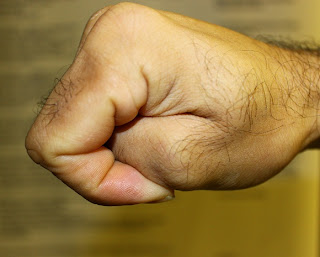Lots of people face hurdles in their Karate lives, physically and mentally.
A while ago I remember teaching some advice workers about disability. Many of them weren't aware of the link between physical and mental health. Many medical practitioners view them as very separate areas of medicine. How can they be?
If you live with a mental illness and it affects your ability to get out and do things (Eg work and play etc), over a period of time, the mental illness will impact your physical health because the lack of movement etc will affect your cardio-vascular system, your stamina and your ability to withstand certain illnesses, as well as causing reduced functions in your limbs (decreased walking distances etc).
If you develop a physical disability that stops you doing things that you previously enjoyed, it may lead to mental health conditions such as depression and perhaps stress related illnesses. The link between stress and heart conditions is well known.
I live with Post Traumatic Stress Disorder and Chronic Pain in parts of my body. I have to be very careful and very aware of the needs of my mind, body and spirit. There are times when I have to stop training for a week in order to allow the pain levels to lessen a little to allow me to get back into the dojo. I've learnt to be flexible and kind to myself; to do what I can, when I can ... but it can be a difficult balancing act.
I know of Karateka that have worse issues than mine to deal with and they carry on fighting the fight within and training at their various dojos; doing what they can, when they can, around the limitations of their disabilities.
Why continue doing something like Karate that can be so taxing?
Exercise decreases stress hormones and increases
endorphins. Endorphins are defined as hormone-like substances that are produced
in the brain and function as the body’s natural painkillers. During
exercise, these endorphins are released, and this can produce feelings
of euphoria and a general state of well-being. The endorphins produced
can be so powerful that they actually mask pain.
Endorphins are chemicals released through exercise, that boost your mood naturally. Exercise also releases adrenaline,
serotonin, and dopamine. These chemicals work together to make you feel
good.
Karate goes further though. It's more than physical exercise. It's a way of life. There's as much to learn outside the dojo as there is within. It's not just a martial art. As a system it looks after the mind, body and spirit ... and once your feet have found it - really found it ... it's a hard path to leave. I'm sure the same can be said of other well established martial arts around the world.
If you have any sort of health problems, pop into your nearest dojo and have a confidential chat with the Sensei (teacher) there and assess them. If you feel that they understand disability issues and can be flexible toward you ... start training with them. If you feel uncomfortable with them, go and see a different Sensei until you find one that will accommodate you.
If you're in the Nottingham area, please feel free to pop in to either of our venues for an informal chat before or after the lessons:
Wednesdays 7:30pm - 9:00pm
Snape Wood Community Association
Snape Wood Road
Bulwell
Nottingham
NG6 7GH
Tel 0115 975 3299
Fridays 7:00pm - 8:30pm
Sundays 10:00am - 11:30am
Bestwood Estate Community Centre
Gainsford Crescent
Bestwood Estate
Nottingham
NG5 5HT
Tel 0115 976 2391
All the best,
Villayat 'Wolf' Sunkmanitu
Meiyo Shotokan Karate Club
























